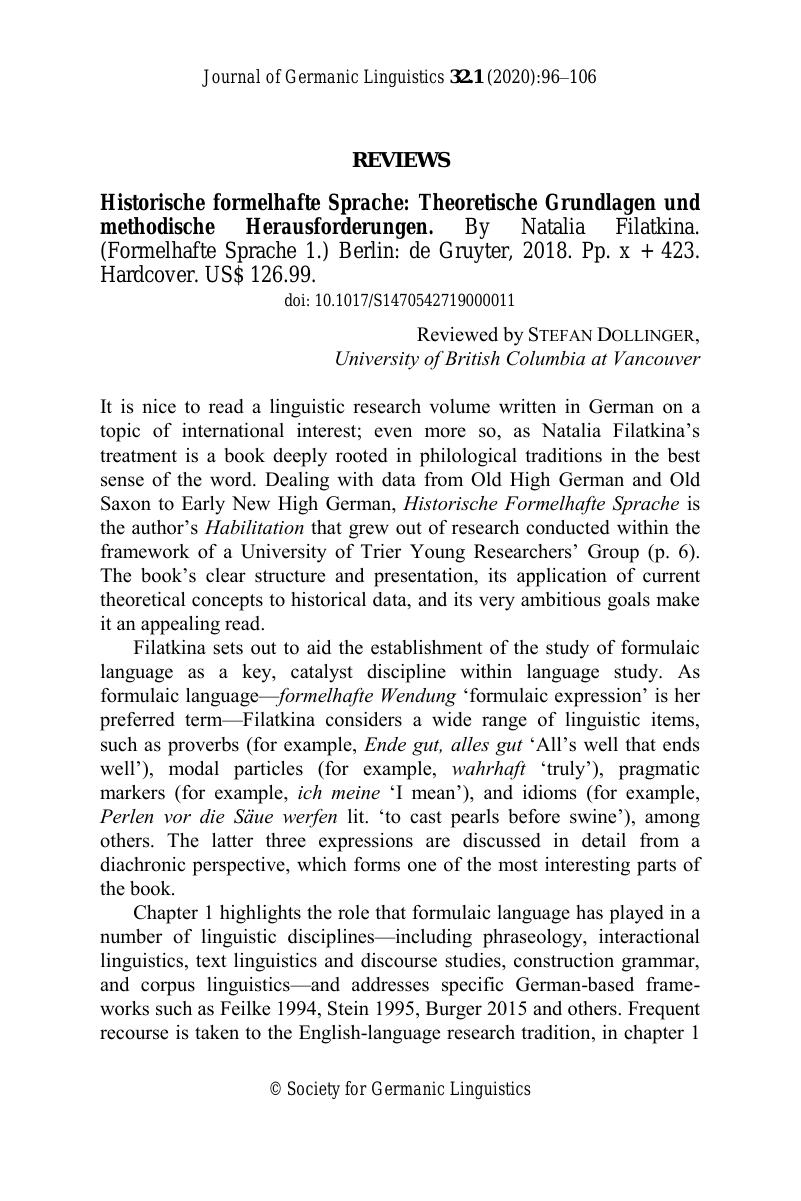No CrossRef data available.
Article contents
Historische formelhafte Sprache: Theoretische Grundlagen und methodische Herausforderungen. By Natalia Filatkina. (Formelhafte Sprache 1.) Berlin: de Gruyter, 2018. Pp. x + 423. Hardcover. US$ 126.99.
Published online by Cambridge University Press: 07 February 2020
Abstract
An abstract is not available for this content so a preview has been provided. Please use the Get access link above for information on how to access this content.

- Type
- Reviews
- Information
- Copyright
- © Society for Germanic Linguistics 2020
References
Brinton, Laurel J. 2008. The comment clause in English: Syntactic origins and pragmatic development. Cambridge: Cambridge University Press.CrossRefGoogle Scholar
Bybee, Joan. 2010. Language, usage and cognition. Cambridge: Cambridge University Press.CrossRefGoogle Scholar
Dollinger, Stefan. 2016. On the regrettable dichotomy between philology and linguistics: Historical lexicography and historical linguistics as test cases. Studies in the history of English VII, ed. by Chapman, Don, Moore, Colette, & Wilcox, Miranda, 61–89. Berlin: Mouton de Gruyter.Google Scholar
Feilke, Helmuth. 1994. Common-Sense-Kompetenz: Überlegungen zu einer Theorie “sympathischen” und “natürlichen” Meinens und Verstehens. Frankfurt am Main: Suhrkamp.Google Scholar
Goldberg, Adele E. 2006. Constructions at work. New York, NY: Oxford University Press.Google Scholar
Havinga, Anna D. 2018. Invisibilising Austrian German: On the effect of linguistic prescriptions and educational reforms on writing practices in 18th-century Austria. Berlin: de Gruyter.CrossRefGoogle Scholar
Labov, William. 1994. Principles of linguistic change, vol. 1,
Internal factors.
Oxford: Blackwell.Google Scholar
Langacker, Ronald W. 1987. Foundations of cognitive grammar, vol. 1. Stanford, CA: Stanford University Press.Google Scholar
Mattheier, Klaus. 2003. German. Germanic standardizations: Past to present, ed. by Deumert, Ana & Vandenbussche, Wim, 211–244. Amsterdam: John Benjamins.CrossRefGoogle Scholar
Stein, Stephan. 1995. Formelhafte Sprache: Untersuchungen zu ihren pragmatischen und kognitiven Funktionen im gegenwärtigen Deutsch. Frankfurt am Main: Lang.Google Scholar
Wierzbicka, Anna. 2013. Imprisoned in English: The hazards of English as a default language. Oxford: Oxford University Press.CrossRefGoogle Scholar
Wray, Alison. 2002. Formulaic language and the lexicon. Cambridge: Cambridge University Press.CrossRefGoogle Scholar




